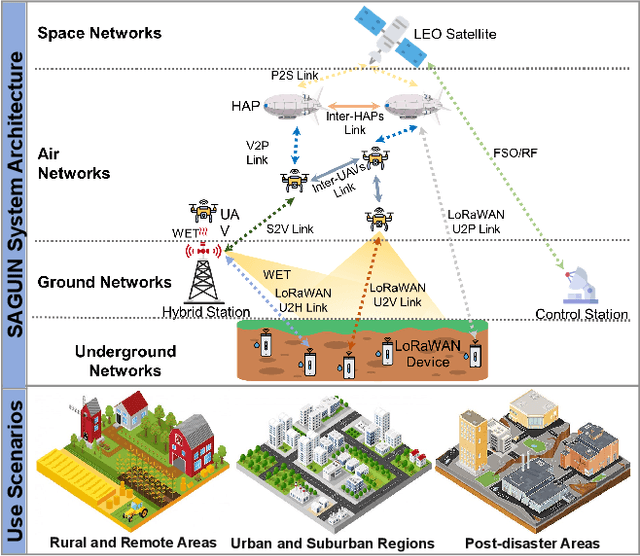Kaiqiang Lin
Toward Sustainable Subterranean mMTC: Space-Air-Ground-Underground Networks Powered by LoRaWAN and Wireless Energy Transfer
Aug 20, 2025



Abstract:Wireless underground sensor networks (WUSNs), which enable real-time sensing and monitoring of underground resources by underground devices (UDs), hold great promise for delivering substantial social and economic benefits across various verticals. However, due to the harsh subterranean environment, scarce network resources, and restricted communication coverage, WUSNs face significant challenges in supporting sustainable massive machine-type communications (mMTC), particularly in remote, disaster-stricken, and hard-to-reach areas. To complement this, we conceptualize in this study a novel space-air-ground-underground integrated network (SAGUIN) architecture that seamlessly incorporates satellite systems, aerial platforms, terrestrial networks, and underground communications. On this basis, we integrate LoRaWAN and wireless energy transfer (WET) technologies into SAGUIN to enable sustainable subterranean mMTC. We begin by reviewing the relevant technical background and presenting the architecture and implementation challenges of SAGUIN. Then, we employ simulations to model a remote underground pipeline monitoring scenario to evaluate the feasibility and performance of SAGUIN based on LoRaWAN and WET technologies, focusing on the effects of parameters such as underground conditions, time allocation, LoRaWAN spread factor (SF) configurations, reporting periods, and harvested energy levels. Our results evidence that the proposed SAGUIN system, when combined with the derived time allocation strategy and an appropriate SF, can effectively extend the operational lifetime of UDs, thereby facilitating sustainable subterranean mMTC. Finally, we pinpoint key challenges and future research directions for SAGUIN.
RIS-aided Wireless-Powered Backscatter Communications for Sustainable Internet of Underground Things
Dec 10, 2024



Abstract:Wireless-powered underground sensor networks (WPUSNs), which enable wireless energy transfer to sensors located underground, is a promising approach for establishing sustainable internet of underground things (IoUT). To support urgent information transmission and improve resource utilization within WPUSNs, backscatter communication (BC) is introduced, resulting in what is known as wireless-powered backscatter underground sensor networks (WPBUSNs). Nevertheless, the performance of WPBUSNs is significantly limited by severe channel impairments caused by the underground soil and the blockage of direct links. To overcome this challenge, in this work, we propose integrating reconfigurable intelligent surface (RIS) with WPBUSNs, leading to the development of RIS-aided WPBUSNs. We begin by reviewing the recent advancements in BC-WPUSNs and RIS. Then, we propose a general architecture of RIS-aided WPBUSNs across various IoUT scenarios, and discuss its advantages and implementation challenges. To illustrate the effectiveness of RIS-aided WPBUSNs, we focus on a realistic farming case study, demonstrating that our proposed framework outperforms the three benchmarks in terms of the sum throughput. Finally, we discuss the open challenges and future research directions for translating this study into practical IoUT applications.
Energy Efficiency Optimization for Subterranean LoRaWAN Using A Reinforcement Learning Approach: A Direct-to-Satellite Scenario
Nov 03, 2023



Abstract:The integration of subterranean LoRaWAN and non-terrestrial networks (NTN) delivers substantial economic and societal benefits in remote agriculture and disaster rescue operations. The LoRa modulation leverages quasi-orthogonal spreading factors (SFs) to optimize data rates, airtime, coverage and energy consumption. However, it is still challenging to effectively assign SFs to end devices for minimizing co-SF interference in massive subterranean LoRaWAN NTN. To address this, we investigate a reinforcement learning (RL)-based SFs allocation scheme to optimize the system's energy efficiency (EE). To efficiently capture the device-to-environment interactions in dense networks, we proposed an SFs allocation technique using the multi-agent dueling double deep Q-network (MAD3QN) and the multi-agent advantage actor-critic (MAA2C) algorithms based on an analytical reward mechanism. Our proposed RL-based SFs allocation approach evinces better performance compared to four benchmarks in the extreme underground direct-to-satellite scenario. Remarkably, MAD3QN shows promising potentials in surpassing MAA2C in terms of convergence rate and EE.
 Add to Chrome
Add to Chrome Add to Firefox
Add to Firefox Add to Edge
Add to Edge